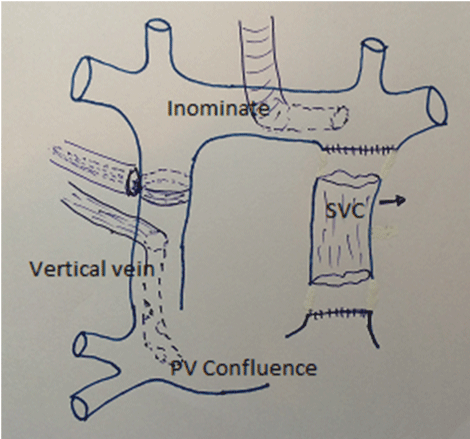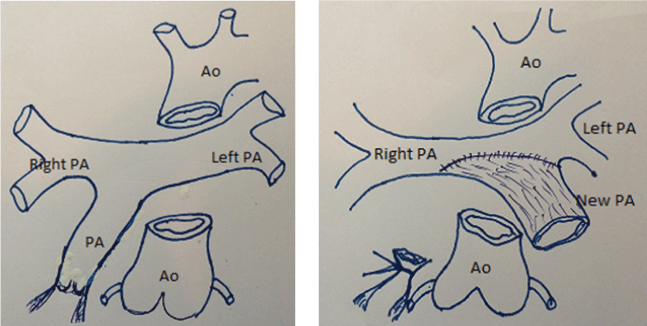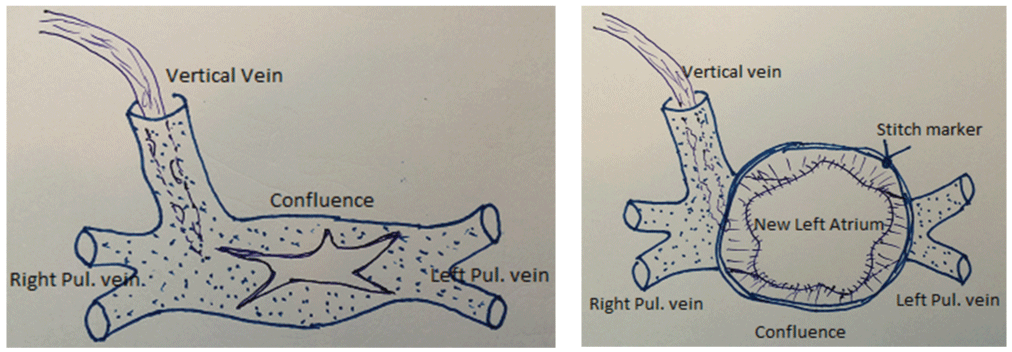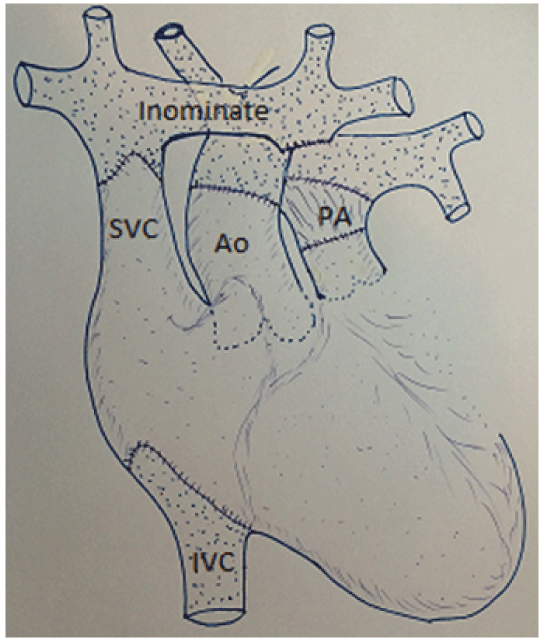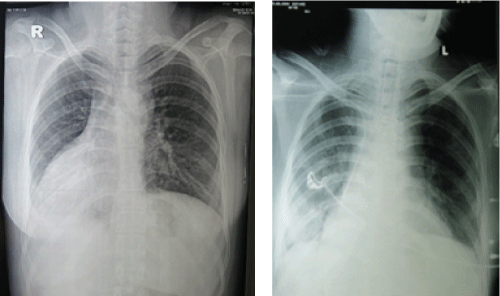International Journal of Clinical Cardiology
Heart Transplant for Dextrocardia Situs Inversus with Very Complex Congenital Lesion: a Challenge of Cardiac Surgery
Nguyen Huu Uoc* and Pham Tien Quan
Department of Cardiovascular and Thoracic Surgery, Viet Duc University Hospital, Hanoi, Vietnam
*Corresponding author: Nguyen Huu Uoc, Associate Professor in Surgery, Department of Cardiovascular & Thoracic Surgery, Hanoi Medical University, Viet Duc University Hospital, Ha Noi, Vietnam, Tel: 84-903239788, E-mail: uocdhyhn101@yahoo.com.vn
Int J Clin Cardiol, IJCC-2-049, (Volume 2, Issue 5), Research Article; ISSN: 2378-2951
Received: May 05, 2015 | Accepted: September 11, 2015 | Published: September 14, 2015
Citation: Uoc NH, Quan PT (2015) Heart Transplant for Dextrocardia Situs Inversus with Very Complex Congenital Lesion: a Challenge of Cardiac Surgery. Int J Clin Cardiol 2:049. 10.23937/2378-2951/1410049
Copyright: © 2015 Uoc NH, et al. This is an open-access article distributed under the terms of the Creative Commons Attribution License, which permits unrestricted use, distribution, and reproduction in any medium, provided the original author and source are credited.
Abstract
Background: Viet Duc Hospital has carried out 9 out of 11 heart transplants in Vietnam since 2010. The vast majority of cases is a heart transplant at the same location i.e. the cardiac stem of the recipient is of the same anatomy with that of the donor. In congenital heart disease (CHD), if the cardiac stem of the recipient is of a disordered structure, it will pose a major challenge for the heart transplant itself as well as the recovery following transplantation. The team at Viet Duc hospital carried out a successful transplant in a particularly complicated case of CHD in May 2014. This report aims to give an overview of this unique procedure and its results.
Method: clinical case report.
Results: 27 year-old female patient had complex CHD that involved dextrocardia situs inversus, double outlet right ventricle type TGA, pulmonary artery stenosis, total atrio-ventricular canal, and total anomalous pulmonary venous connection type supra-cardia. She was experiencing end-stage heart failure and severely cachexia with risk of death within few months. The transplanted heart was from a multi-organ donor; male, 26 years old, normal heart structure. Although the difference in biological parameters between donor and recipient were with in acceptable limits, most of the steps in an otherwise normal transplant proved to be highly challenging. For instance, the team had to create a new cardiac cavity on left chest and the "left" atrium chamber at a suitable location, repair and transfer the pulmonary artery to the posterior-left position, and transfer the superior-inferior vena cava to the right location. The transplant lasted 9 hours with 170 minutes of aortic cross-clamp time. Recovery from surgery was highly chalenging with risks of multi-organ failure and ventilator-associated lung injury. Intra-aortic balloon pump was used for 8 days, continuous renal replacement therapy for 5 weeks, tracheostomy and mechanical ventilation for 10 weeks. Total time in hospital post-surgery was 3.5 months. Good improvement was observed at one-year follow-up.
Conclusion: This is a very rare case of heart transplant which was further complicated by pre-existing dextrocardia. It presented highly uncommon challenges that called for inventive techniques. The team's experience in managing complex CHD and cardiac transplant was the most important factor that contributed to the success of the procedure.
Keywords
Heart transplant, Dextrocardia, Congenital heart disease, Viet Duc hospital
Introduction
Heart transplant is a common type of cardiac surgery in the world with more than 3,500 cases carried out per year mainly in the European countries and United States of America (USA) [1]. In Vietnam, heart surgery has been thriving for more than 20 years, but has only been of interest in recent years due to historical and economic factors. 11 cases of cardiac transplant have taken place so far with post-operative survival rate of 100%. Bicaval heart transplantation with 5 anastomosis in the vascular roots (left atrium, 2 venacava, pulmonary artery and the aorta) was the predominant technique [2], which was used in 9 cases in Viet Duc hospital. In most cases the hearts of donor and recipient are on the left with vascular roots symmetrical to each other.
The heart located on the right side - dextrocardia, is a rare malformation found in 1 in 12,000 people. In the form situs inversus, about a quarter of cases also have congenital heart disease (CHD) [3,4]. For a patient with dextrocardia who requires a heart transplant, managing the inverted vascular roots is of the highest technical difficulty as the heart of donor is often in the normal position on the left. Finding a donor with dextrocardia is virtually impossible. There are few reports in literature about heart transplant for patients with dextrocardia situs in versus and complex CHD, which often emphasised on managing the roots of the superior and inferior vena cava, and did not include cases with complex deformities occurred in four of the five anastomoses of the heart transplant.
In May 2014, we successfully implanted a normal heart into a recipient with dextrocardia situs inversus and complex CHD that involved double outlet right ventricle type TGA, pulmonary artery stenosis, total atrio-ventricular canal, and total anomalous pulmonary venous connection type supra-cardia. Through this report we hope to contribute our experience managing a unique transplant with a focus on the surgical techniques employed.
Summary
Recipient
P.T.T, female, 27-years old, former university student from Hanoi, Vietnam
History
Severe CHD with dextrocardia situs inversus was diagnosed soon after birth due to cyanosis. The patient visited major cardiovascular centres in Vietnam with no treatment offered due to overly complicated lesions. Her condition became increasingly serious and at the age of 22, the patient had to drop out of university following multiple malaise crises that involved repeated hospitalisation to undergo blood dilution therapy and heart failure treatment.
In February 2014, the patient was referred to Viet Duc hospital for the last opportunity to extend survival by means of organ transplant. Upon admission patient had serious cachexia (weighing 39-40 kg, not sit up well) and severe cyanosis (SpO2 < 65% when not breathing oxygen and 70-75% when breathing oxygen), undergoing treatment with anticoagulation and low-dose diuretic. Patient was only expected to survive a few months. Extensive testing and measurement were done: echocardiography, cardiac catheterisation to measure pressure in the pulmonary artery and the heart chambers, great arterial dimension, collateral systemic-pulmonary level, CMRI, multi-slides CT, and multi-organic functions amongst others.
The main lesions at the heart included (Figure 1):
- Dextrocardia situs inversus
- Double outlet right ventricle type TGA; pulmonary artery was the back-right of the aorta, aortic cross turned to the left
- Pulmonary artery stenosis: hypoplasia of the ring and trunk of pulmonary artery (12 mm), pulmonary valvular stenosis, though valvular max-gradient is 75 mmHg; good dimension of two pulmonary branches (15.5 mm on the right and 14.5 mm on the left); no patent doctus arteriosus; very poor systemic-pulmonary collateral system
- Total atrio-ventricular canal with severe common valvular failure
- Total anomalous pulmonary venous connection type supra-cardia: relatively large vertical vein on the right (17 mm) compared to the superior vena cava located on the left (22 mm)
- No malfunction the other organs.
Despite the complex cardiac lesions and cachexia, we proceeded to indicate a heart transplant having thoroughly considered the following:
- There was no pulmonary arterial hypertension and poor systemic-pulmonary collaterals
- The size of the pulmonary artery branches was within normal limits
- The patient is young with an otherwise promising life span
- Her parents were determined to seek one last opportunity for their daughter
- Through discussion, we had found solutions to address the heart vessels roots and enable compatibility with a normal heart.
When waiting a donor, the patient suffered a cerebral infarction 6 weeks before the heart transplant took place. Fortunately the lesion was small (< 20 mm) and healed well, leaving non-serious sequelae.
• Donor: male, 26-years old had a heart of normal structure and function with situs solitus; brain dead due to cranial trauma three days before. Opted to donate four organs: heart, liver, and two kidneys, which enabled four transplants to be carried out simultaneously in Viet Duc hospital.
• Compatibility between donor and recipient was within the limit acceptable for a cardiac transplant (Table 1). Although the compatibility was not ideal, we decided to proceed because the recipient was not able to wait any longer.
![]()
Table 1: Donor-recipient compatibility
View Table 1
• Surgical technique: The unusual heart transplant took place on May 26 2014 with a set of technical challenges and procedures that may differ from conventional transplantation.
For the team harvesting the donor heart, the vascular roots took longer to tackle, especially at the two vena cava. For the team implanting the healthy heart, an early start was required to allow for preparation of the vascular roots and cardiac cavity in the left side of the chest. An overview of the process performed on the recipient is as follows:
o. Connect superior vena cava cannulatoinnominate vein, keeping the tube bent to the left. Inferior vena cava cannula maximum distance out to the periphery. Placecannula for pulmonary veins on the right vertical vein.
o. Start aortic cross-clamping, use warm cardioplegia solution to stop the heart and aid the manipulation techniques. Cut into the superior vena cava (SVC) and keep a portion to be used as a graft on the right vertical vein during the transplant (if necessary). Close both ends of SVC (Figure 2).
o. Prepare a cardiac cavity in the left side; vertically open the pericardium on the left pleura cavity, use an artificial patch to extend the pit and to accommodate a new heart on the left (no interference or repair of the old cavity on the right).
o. Bisect the ascending aorta in front of the left pulmonary artery. Cut the pulmonary artery (PA) at supra-valvular location. Open the left wall of pulmonary trunk to the left branch. Use a part of the pericardium to repair and expand PA (20 mm in diameter), orientating to the left as seen in normal hearts (Figure 3).
o. Remove the damaged heart, leaving the back of the left atrium and a large portion of the right atrium connected to the inferior vena cava (IVC). Dissect and resect all atrial tissues to reveal a clear pulmonary vein confluence. Open the confluence in star shape and use a large piece of pericardial patch to expand to the equivalence of the left atrium chamber in normal people. Stitch a marker into the "new left atrium" at position corresponded to the left atrial appendage of the heart transplant (Figure 4).
o Place the healthy heart into the cardiac pit and perform the five anastomoses below (not dissimilar to normal transplants):
1. Donor's left atrium to the "new left atrium" of recipient
2. Use the remainder of recipient's right atrial tissue and IVC to reconstruct and create a new conduction from recipient's IVC, positioning to the left of the spine and turning just enough to avoid straining and twisting
3. Pulmonary arterial and aortic anastomosis
4. Cut the right vertical vein just before pulmonary venous cannula and attach directly to donor's SVC (we had sufficient length and did not require the use of a graft made of SVC portion) (Figure 5).
The next phase of the surgery was similar to a normal heart transplant, which involved the ligature of vertical vein after the cannula of pulmonary vein was removed. The cardio-pulmonary bypass lasted for 170 minutes compared to 80 minutes in normal transplants; the operating time was 9 hours compared to 4-5 hours of regular transplants.
On closing the sternum, there was a compression on the heart due to its size which was larger than the recipient's chest could accommodate. We applied the same technique as sternal external fixation used in chest wall injuries and stretched with 2000-gram weight.
• Post-operative recovery in ICU: Postoperative events were complex and challenging due to a number of factors, including compression on the new heart in the first few days (which led to heart failure and low cardiac flow, though the left ventricular contracted well), oliguria and anuria (due to low cardiac flow and potential renal failure before operation), and prolonged respiratory failure (due to respiratory muscle atrophy as part of patient's severe cachexia and inflammation of the respiratory system).
• Main interventions in post operative period included intra-aortic balloon pump (IABP) in the first eight days, continuous renal replacement therapy (CRRT) for five weeks and tracheotomy in the sixth week, use of artificial respirator for ten weeks in total, and physiotherapy and respiratory therapy within two months.
• Treatment with immuno-inhibitors was indicated as per normal heart transplant, following the protocol starting with Basiliximab. The dose was adjusted according to the blood immuno-inhibitor concentration, which was regularly examined. The total hospital stay after surgery was 3.5 months. Prior to discharge patient was in stable condition with favourable heart function and able to perform basic activities (Figure 6).
• Follow-up after discharge: Patient attended monthly check-up and underwent mobilisation therapy at home. As of May 2015 (a year after surgery), her cardiac and respiratory functions had returned to normal and no signs of graft rejection were observed; she could perform daily activities and was hoping to resume her studies at university.
Discussion
While heart transplantation has become more common in developed countries and some developing countries (in Asia) with fairly standardised techniques and Bicaval procedure [1,2], a heart transplant in a patient with dextrocardia situs inversus and complex CHD is very rare due to a variety of reasons, including the extremely low incidence of dextrocardia [3,4] and the limited indication of heart transplant for the CHD group. From the technical perspective, it would be ideal to find a donor with dextrocardia and with the vascular roots compatible with those of the recipient's; but this is very unlikely. As a result, there has been limited publication about heart transplants that involve recipients with dextrocardia situs inversus and CHD and donors with normal hearts in situs solitus. The reports we found mainly discussed the structural disorders of vascular roots such as mirrored vena cava and transposition of great arteries, or palliative procedure like Fontan [5]. We had yet to encounter any report about supracardiac type total anomalous pulmonary venous connection, which means the recipient does not have a normal heart atrium required for the most important anastomosis in transplant. Doty et al. outlined the technical difficulties and reconstruction method using pericardium for SVC and IVC [6]; Chang et al. use of the right atrial wall of recipient to reconstruction for IVC's tube [7]; Rubay et al. handled abnormal lesions of the vena cava by the aortic homograft, recipient's right atrial wall and pericardium [8]. In short, most of the reports were to share the experience treating the mismatch of vena cava position between donor and recipient, some of which has been applied to our patients, such as the use the recipient's right atrial wall to create a tube to the IVC on the left side.
In Vietnam, due to historical and economic factors, organ transplant only became a topic of interest in 2010. We had done eight successful heart transplants prior to the case being reported, where all recipients had normal hearts in situs solitus with myocardial dilatation and coronary artery disease; the team had no prior experience performing heart transplanton a recipient with this unique set of condition. Combined with the limited knowledge from publication as discussed above, the case naturally posed some major challenges which primarily involved operating techniques and post-operative treatment. At the same time, we have the resources to perform this type of complicated heart transplant, the most invaluable of which is the experience being the oldest heart surgery centre in Vietnam with over 50 years of history. Our experience includes, and is not limited to, congenital heart surgery (on average about 300 congenital cases in 700 cases of open-heart surgery per year), running ICU units for surgery with modern equipmentand amplemeans of support, such as ECMO, IABP, and CRRT, and the management of patients of all categories including neonates, elderly, aortic dissection type A (70 cases per year), multiple valvular and coronary diseases.
In managing this particular patient, the first milestone was the decision to indicate a heart transplant. Based on our knowledge from literature as well as our experience in congenital heart surgery, sufficient size of PA branches and poor systemic-pulmonary collaterals in older children and adults are indicators that complex CHD can be completely repaired. A heart transplant enables complete repair and, if done thoroughly, the prognosis can be more promising than other approaches. Any difficulty related to rehabilitation after surgery can be addressed by means of available support. In young patients with an otherwise long life expectancy, the decision is also supported by a strong desire of the patient to extend survival and the important element of encouragement from their family. With respect to the donor-recipient compatibility, although not ideal for a heart transplant [9,10], it was not a contra-indication. Lastly and most importantly, the patient could not afford to wait any longer to receive a heart transplant, considering that we only have two donors per year on average at up to 9-10 months apart.
Within the frame work of this report, we focus on sharing the surgical technique that was successfully applied. Due to the complicated anatomical lesions of the recipient, we put a lot of thoughts into planning and executing the operations, and through our intimate experience with the processes, we have drawn some experience below that certainly benefits our practice and we believe can be useful to our colleagues.
First of all, it is crucial that the operating team analyses the lesions thoroughly and calculates the exact timing of the surgery. Technical diagrams should be drawn and incorporated into the specific steps of the process. Having taken these measures, 95% of the specifications we prepared before the transplant fit into the actual operation.
During the operation, in order to make the most of the anatomical structures available to the reconstruction of abnormal vessels, we have a few suggestions below:
• Open the pulmonary venous confluence in a star shape (as done in the correction technique for supracardiac type total anomalous pulmonary venous connection), and use the pericardium to expand into the left atrium chamber, making it similar to the normal left atrium. Mark the position of left appendage (with the stitches) to avoid twisting the screw during the heart transplant.
• For reconstruction of the two venacava, use a SVC graft on the right vertical vein or harvested vascular portions from the vena cava or aorta of the donor or recipient. Take advantage of the right atrial wall to help lengthen IVC tube.
• For PA reconstruction, the pericardium is still the best material. This should be done before the transplant to allow a larger operating field and technique to be applied more accurately.
Following the preparations, caution should be taken during the operation to ensure a close adherence to the standard procedure. The team harvesting the heart should try to retain the maximum length of the vascular roots, especially with the vena cava -SVC should be collected all the way to innominate veins and IVC to supra-liver veins; this will be beneficial to forming the vascular roots during implantation. The team operating on the recipient should begin earlier than normal to allow time for preparation of the heart pit in the left side of the chest and restructuring of the vascular roots; this will help to minimise the preservation time and consequently the risk of ischemia-reperfusion injury to the donor heart. Cardioplegic solution to stop the heart should also be used to stop the heart and enable more precise technical manoeuvres.
During the implantation, even with thorough planning involved, there may well be circumstances that are outside of what has been anticipated. When the donor heart is too large for the recipient's chest, for instance, a possible solution is to create a bigger pit on the left side and to stabilise the sternum with external fixation. Alternatively, we would expect it to open the sternum within a few days after transplant. Bleeding around anastomoses is another major technical challenge in complicated heart transplants like this one. If bleeding is difficult to control, potentially causing complications, the anastomoses should be done with exceptional care and bioglue should be used immediately after each suture, particularly when the anastomosis takes place in the back like in the case of the left atrial reconstruction suture, sewing of the left atrium, connecting of the IVC, or extension of the PA.
After the transplant, because postoperative events can be unpredictable and sometimes even critical, postoperative care should be exceedingly well-organised, taking into account medical personnel (with a separate duty team), equipment support, and psychological preparation for the patient and their family. At this stage, the prognosis is heavily dependent on the quality of postoperative care, the final goal of which should be to support the patient to complete recovery.
Conclusion
In summary, this is a rare case of dextrocardia with situs inversus further complicated by CHD that required a heart transplant. For this particular operation, we believe the team's extensive experience with complex CHD and cardiac transplantation primarily contributed to the successful outcome. Thorough consideration and selection of surgical techniques, which have been the focus of this report, should be among the first priorities for the small number of similar cases. While heart transplantation is no longer a challenge for many centres of heart surgery in the region, we hope that our technical insights from successfully treating this unique patient will be a meaningful contribution to the field.
References
-
Stehlik J, Edwards LB, Kucheryavaya AY, Benden C, Christie JD, et al. (2011) The Registry of the International Society for Heart and Lung Transplantation: Twenty-eighth Adult Heart Transplant Report-2011. J Heart Lung Transplant 30: 1078-1094.
-
Ibrahim Kara, Kaan Kirali, Cevat Yakut (2012) A comparison of the results of the bicavalorthotopic heart transplantation in the surgical technique: A review and meta-analysis. Türk Gögüs Kalp Damar Cerrahisi Dergisi 20: 672-681.
-
Bohun CM, Potts JE, Casey BM, Sandor GG (2007) A population-based study of cardiac malformations and outcomes associated with dextrocardia. Am J Cardiol 100: 305-309.
-
Abbotts ME, Meakins JC (2015) On the differenciation of two forms of congenital dextrocardia. Bulletin of the International Association of Medical Museums 134-138.
-
Beiras-Fernandez A, Daebritz SH, Kaczmarek I, Kozlik-Feldmann R, Tiete AR, et al. (2007) Challenging venous reconstruction and heart transplantation in a patient with congenital atrial complex viscera-heart and inversus disease with Fontan circulation. J Heart Lung Transplant 26: 290-292.
-
Doty DB, Renlund DG, Caputo GR, Burton NA, Jones KW (1990) Cardiac transplantation in situs inversus. J Thorac Cardiovasc Surg 99: 493-499.
-
Chang YL, Wei J, Chang CY, Chuang YC, Sue SH (2008) Cardiac transplantation in situs inversus: two cases reports. Transplant Proc 40: 2848-2851.
-
Rubay JE, d'Udekem Y, Sluysmans T, Ponlot R, Jacquet L, et al. (1995) Orthotopic heart transplantation in situs inversus. Ann Thorac Surg 60: 460-462.
-
de Jonge N, Kirkels JH, Klopping C, Lahpor JR, Caliskan K, et al. (2008) Guidelines for heart transplantation. Neth Heart J 16: 79-87.
-
Neves C, Prieto D, Sola E, Antunes MJ (2009) Heart transplantation from donors of different ABO blood type. Transplant Proc 41: 938-940.






